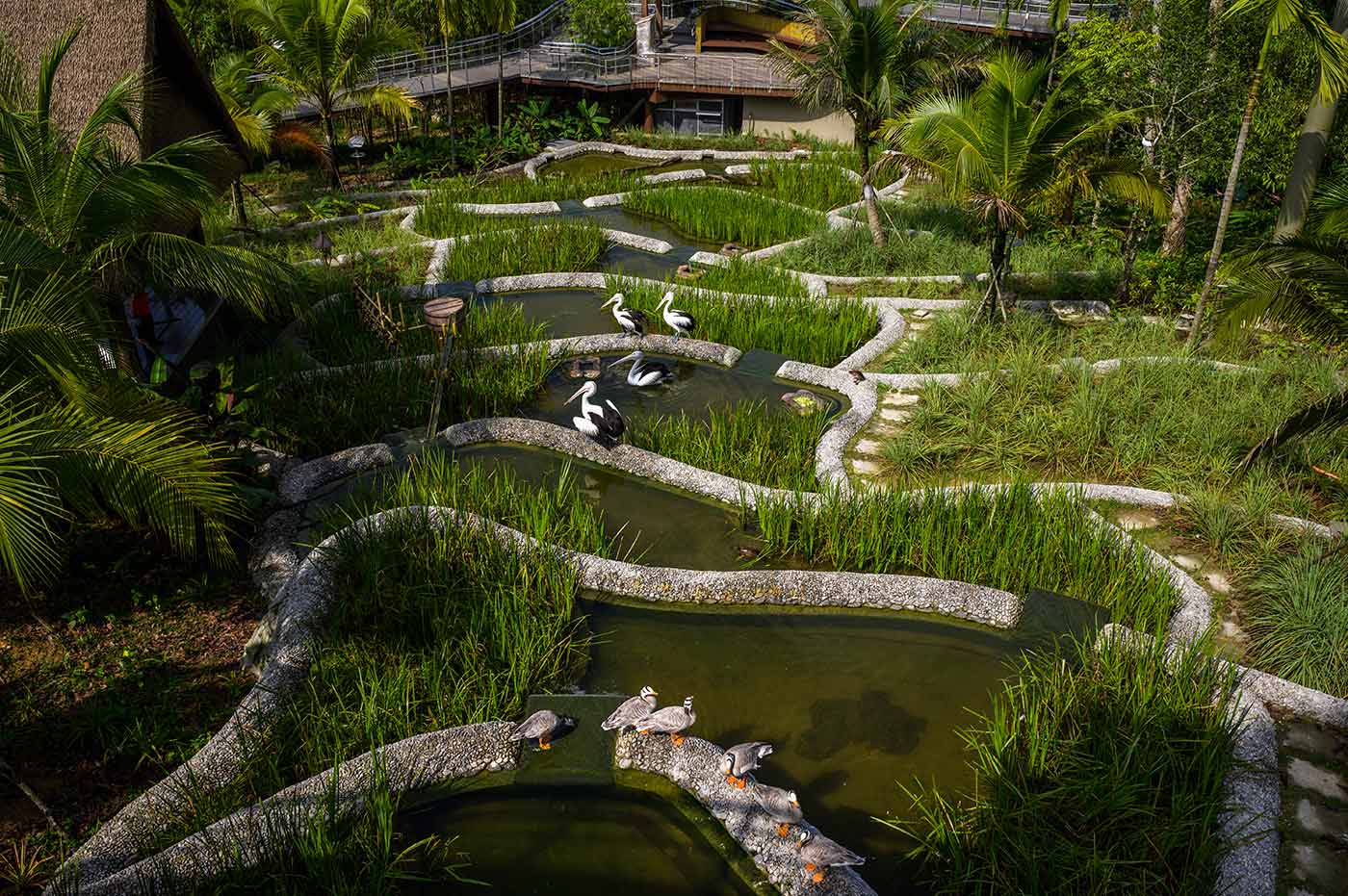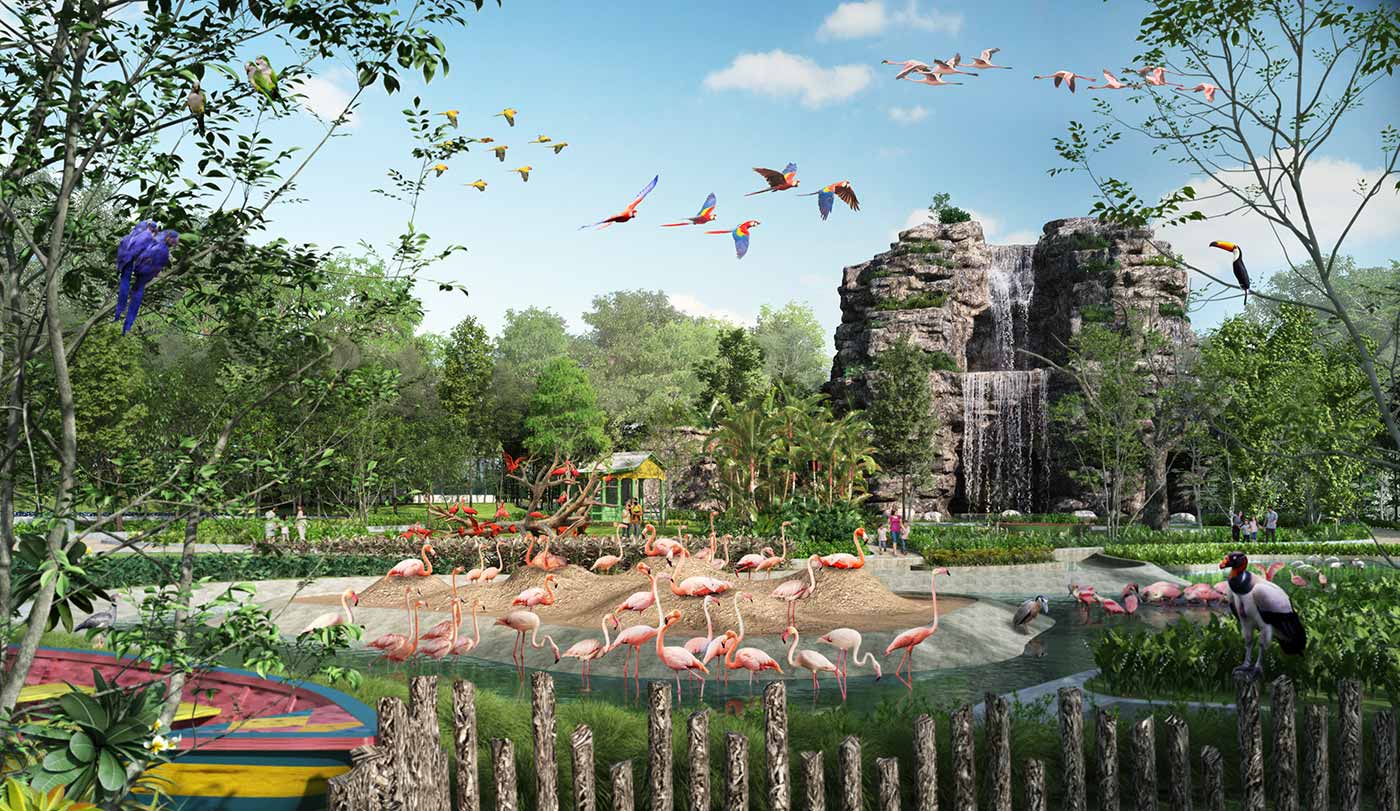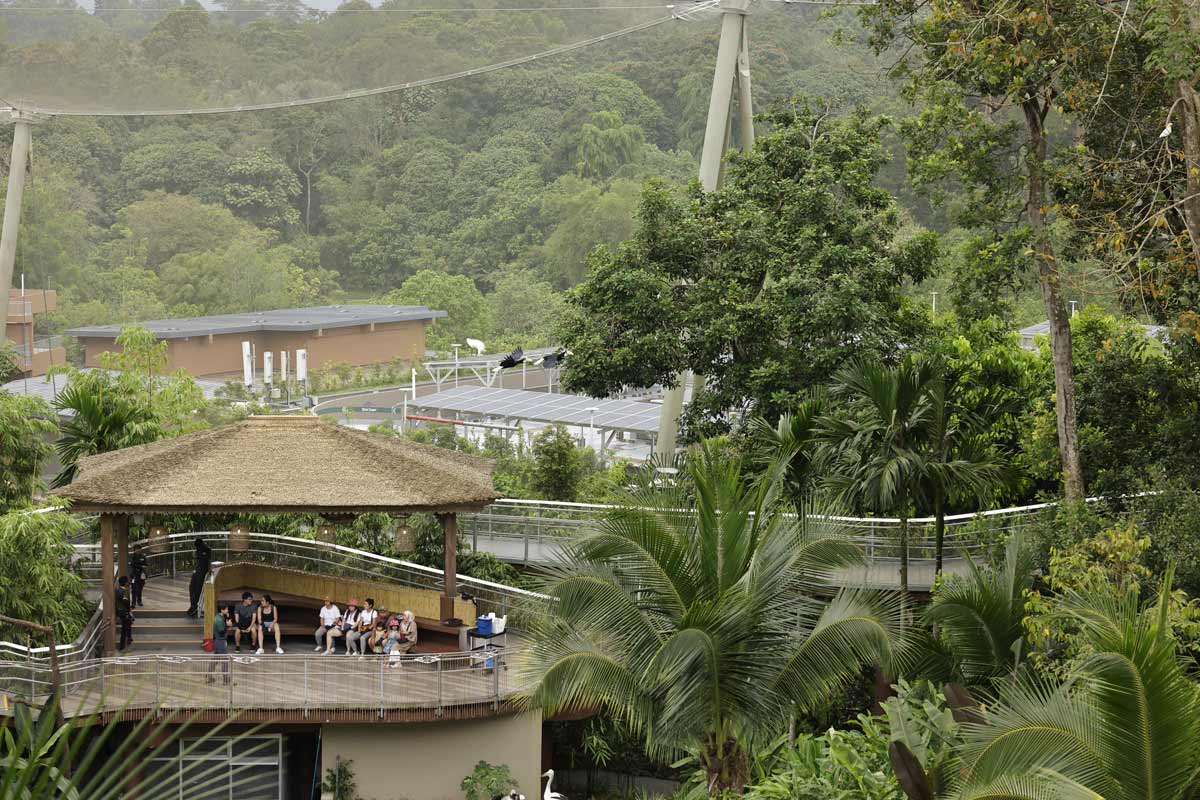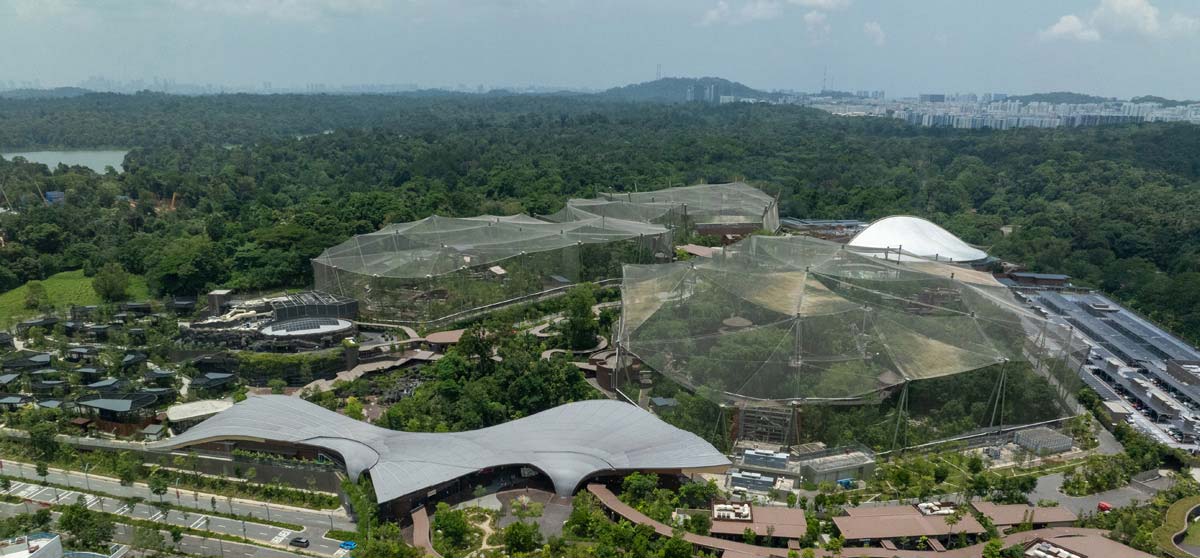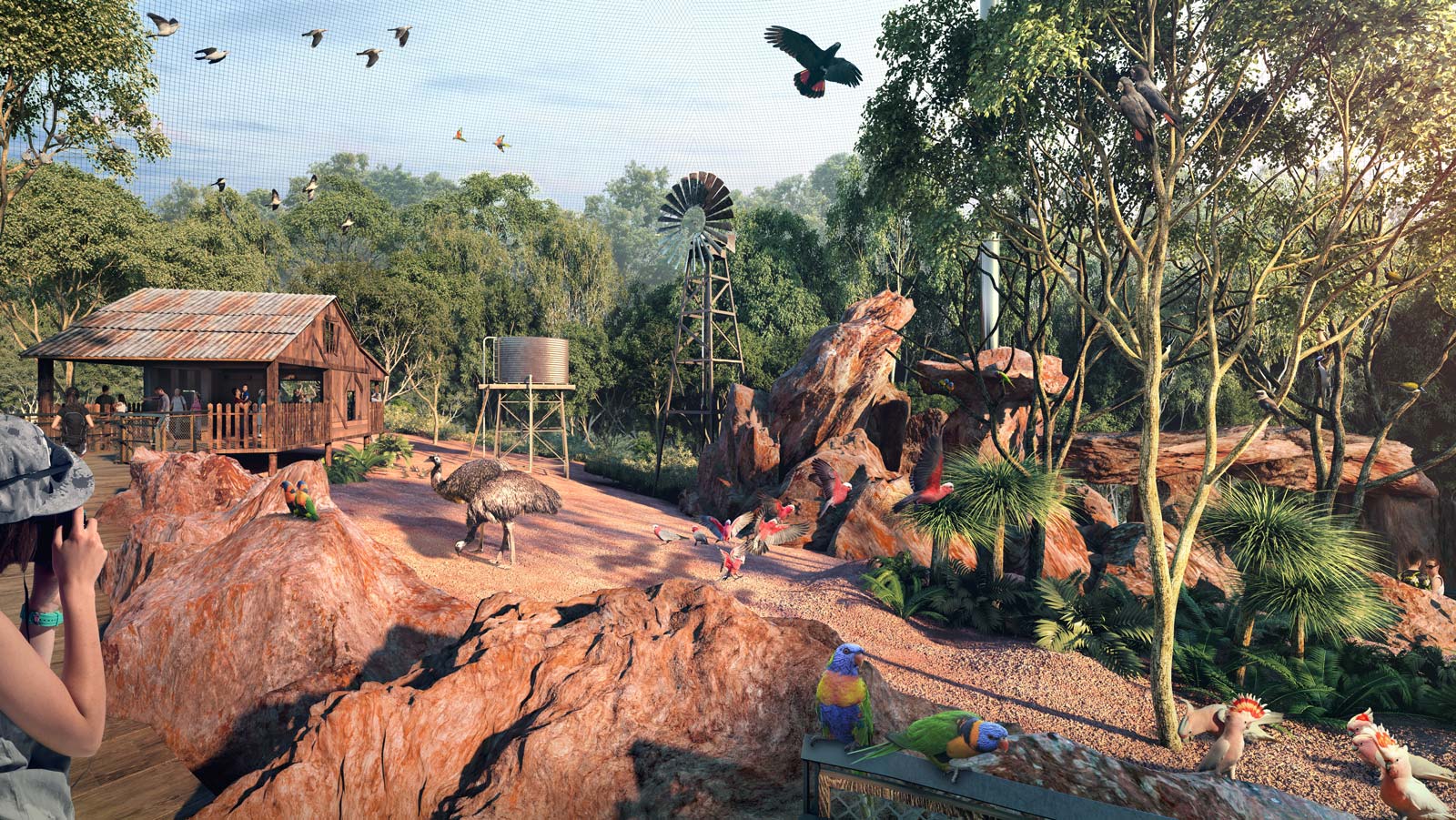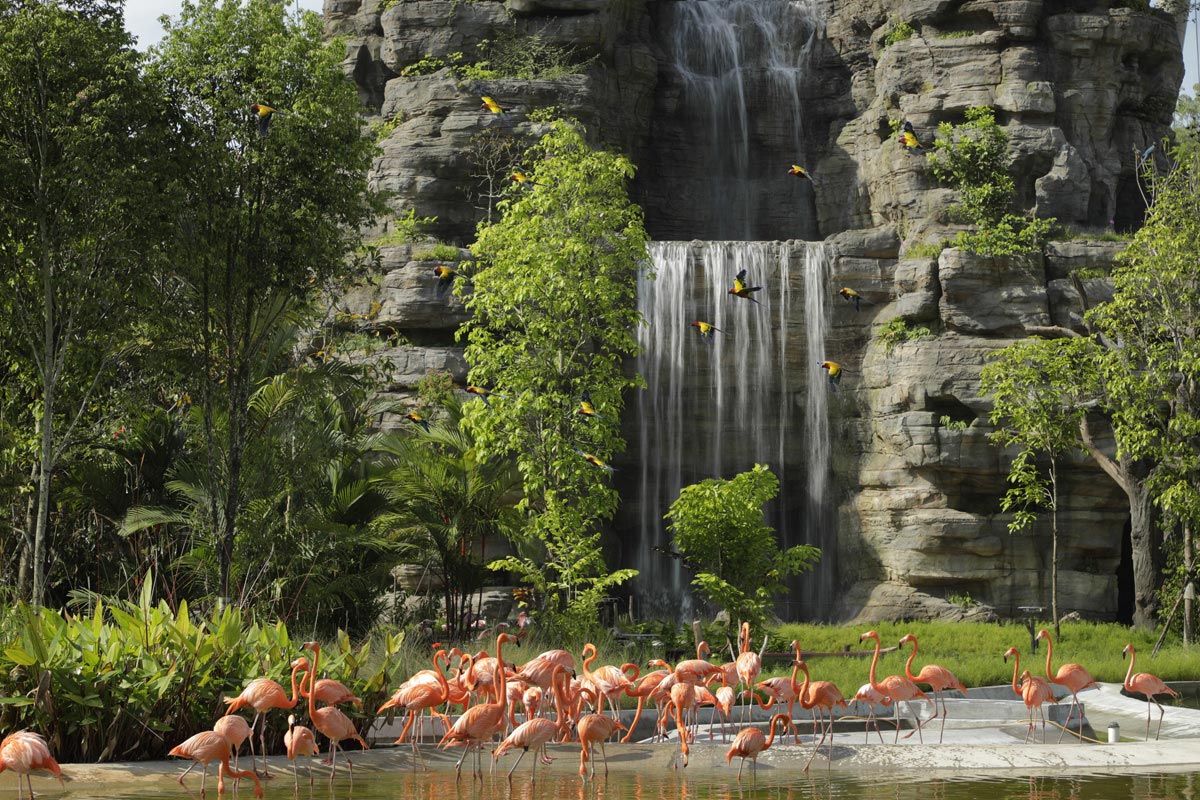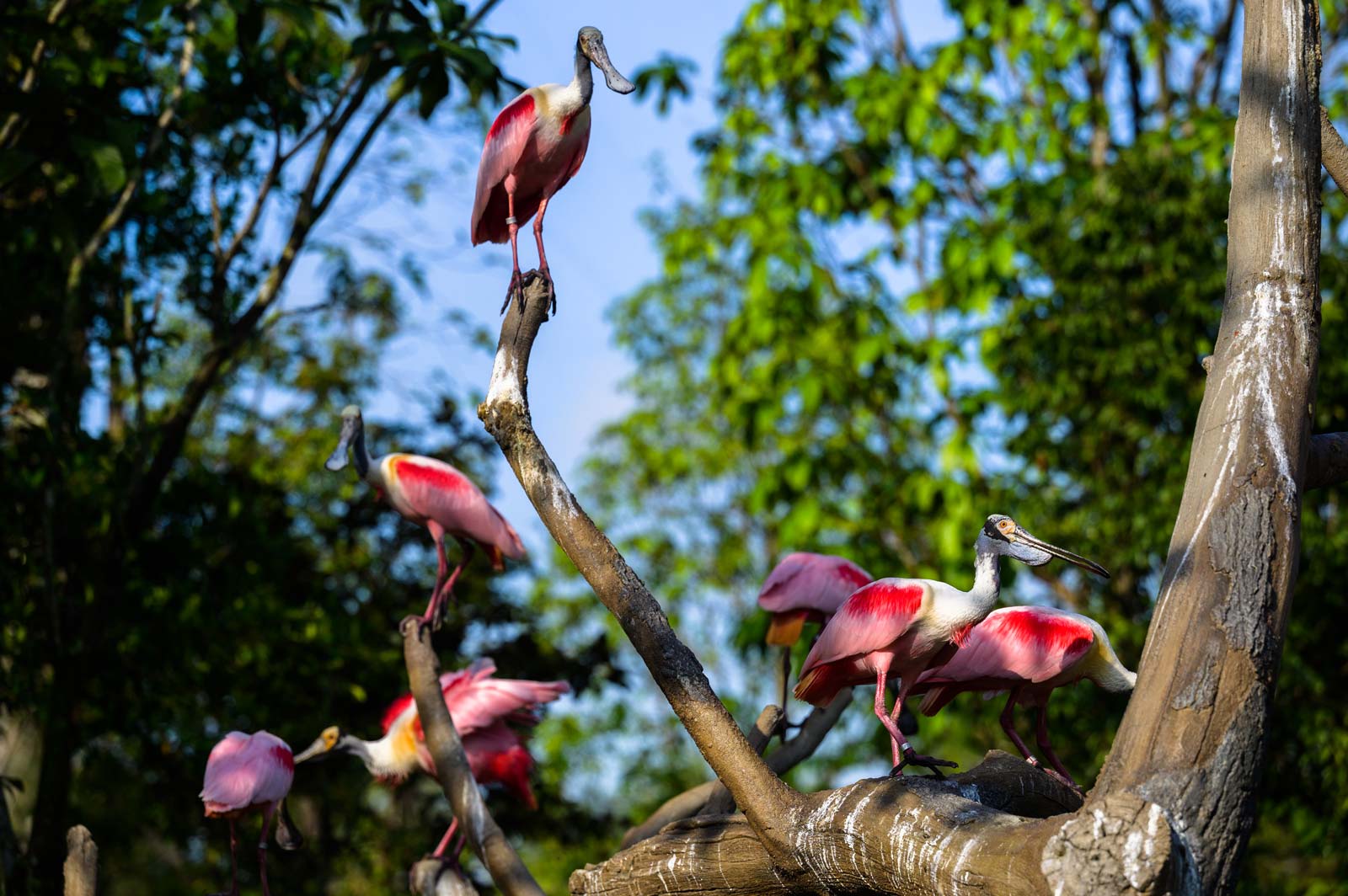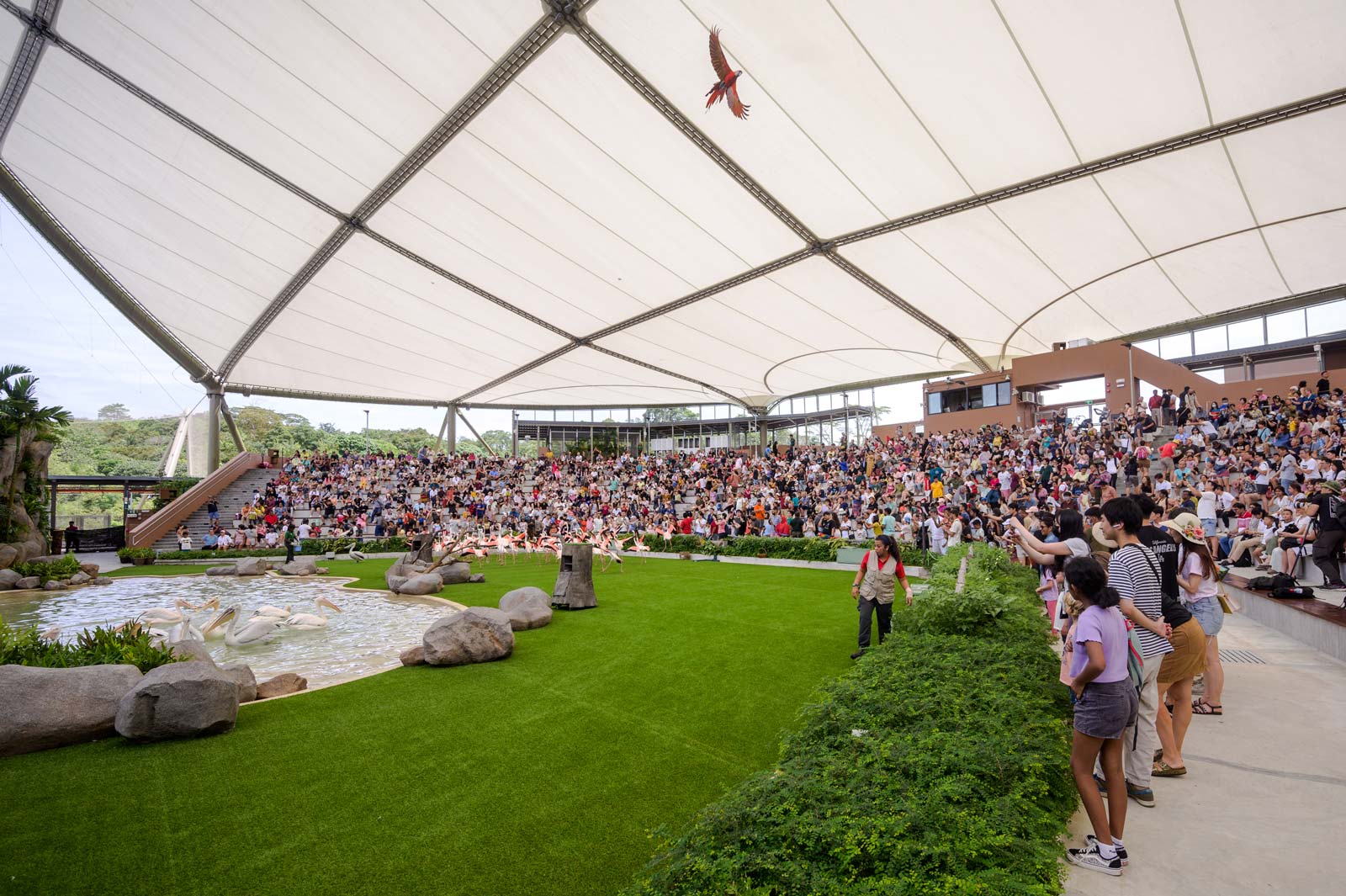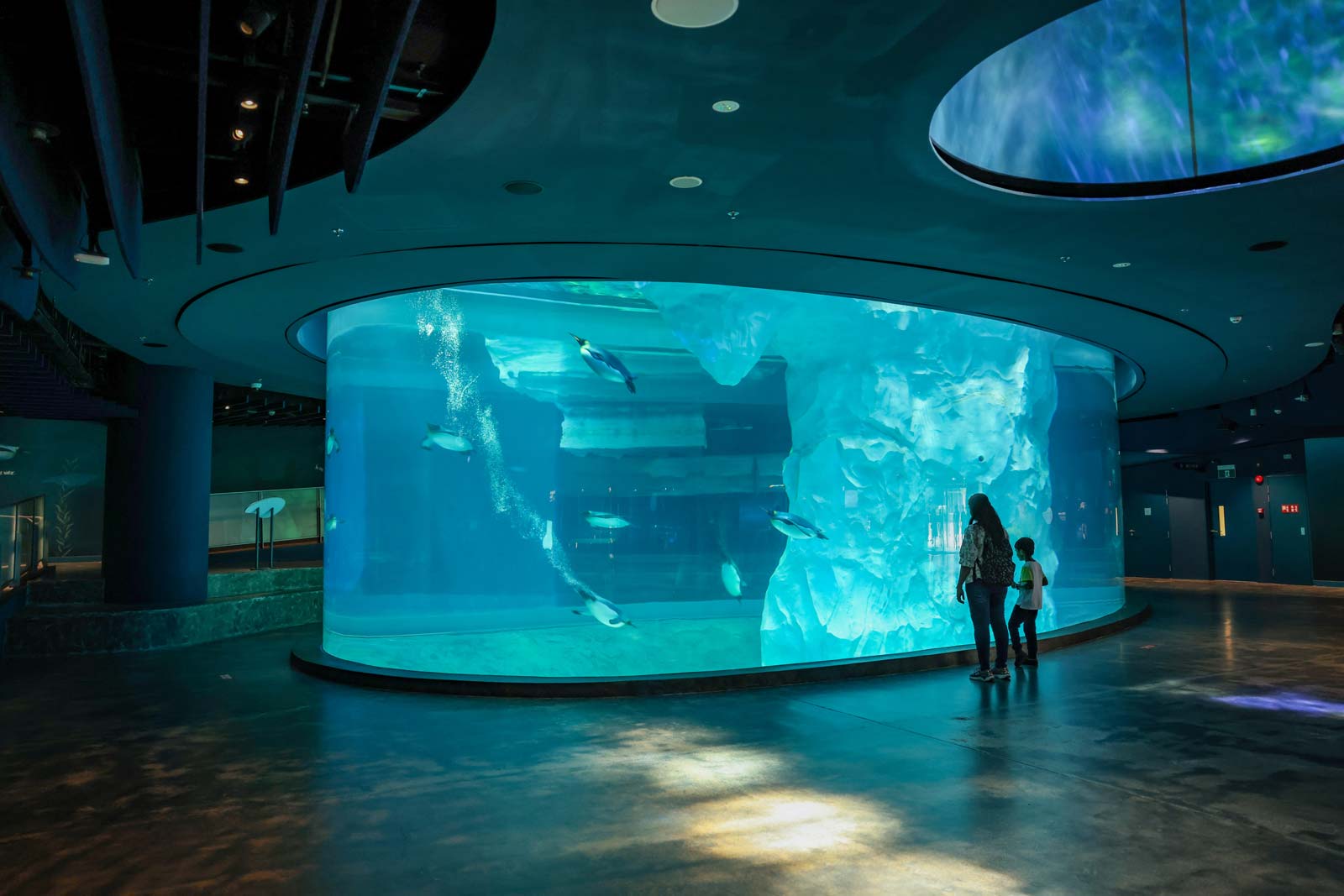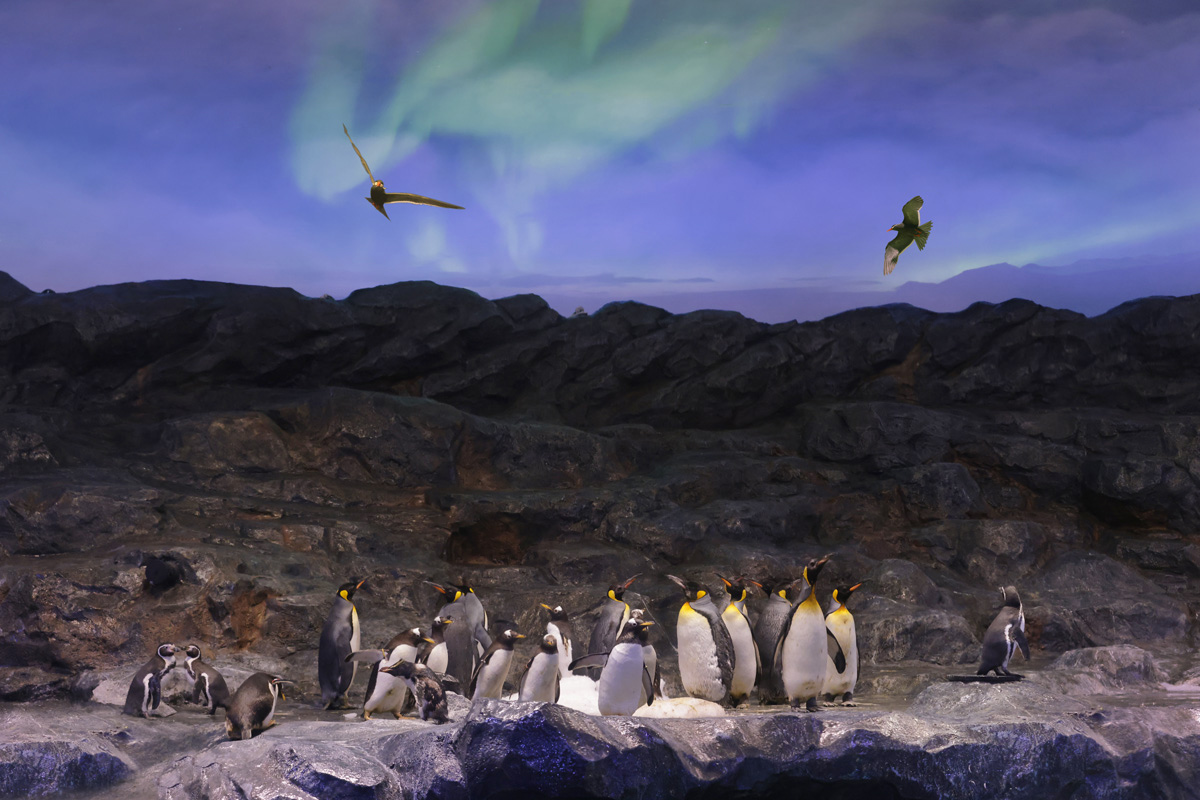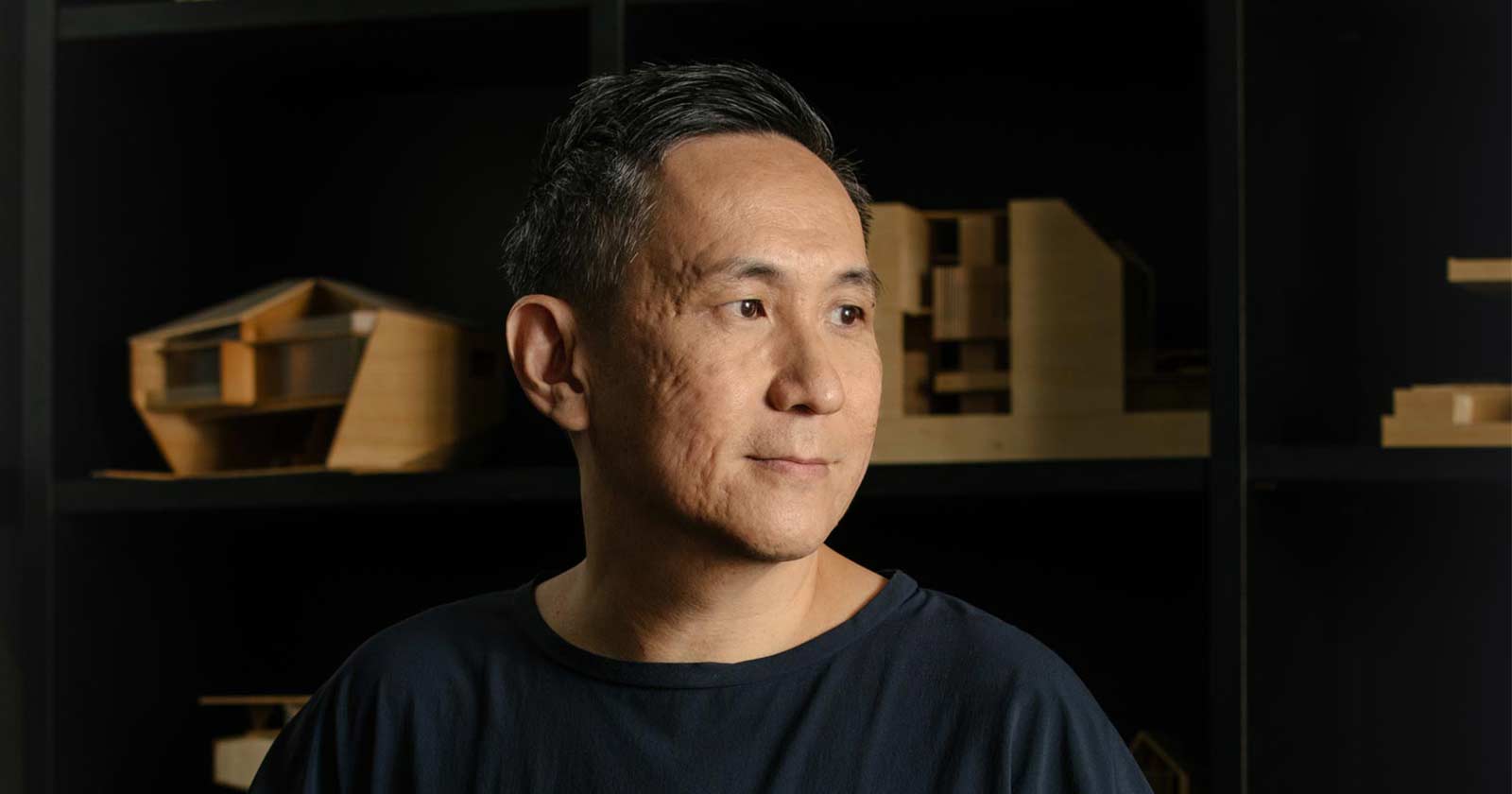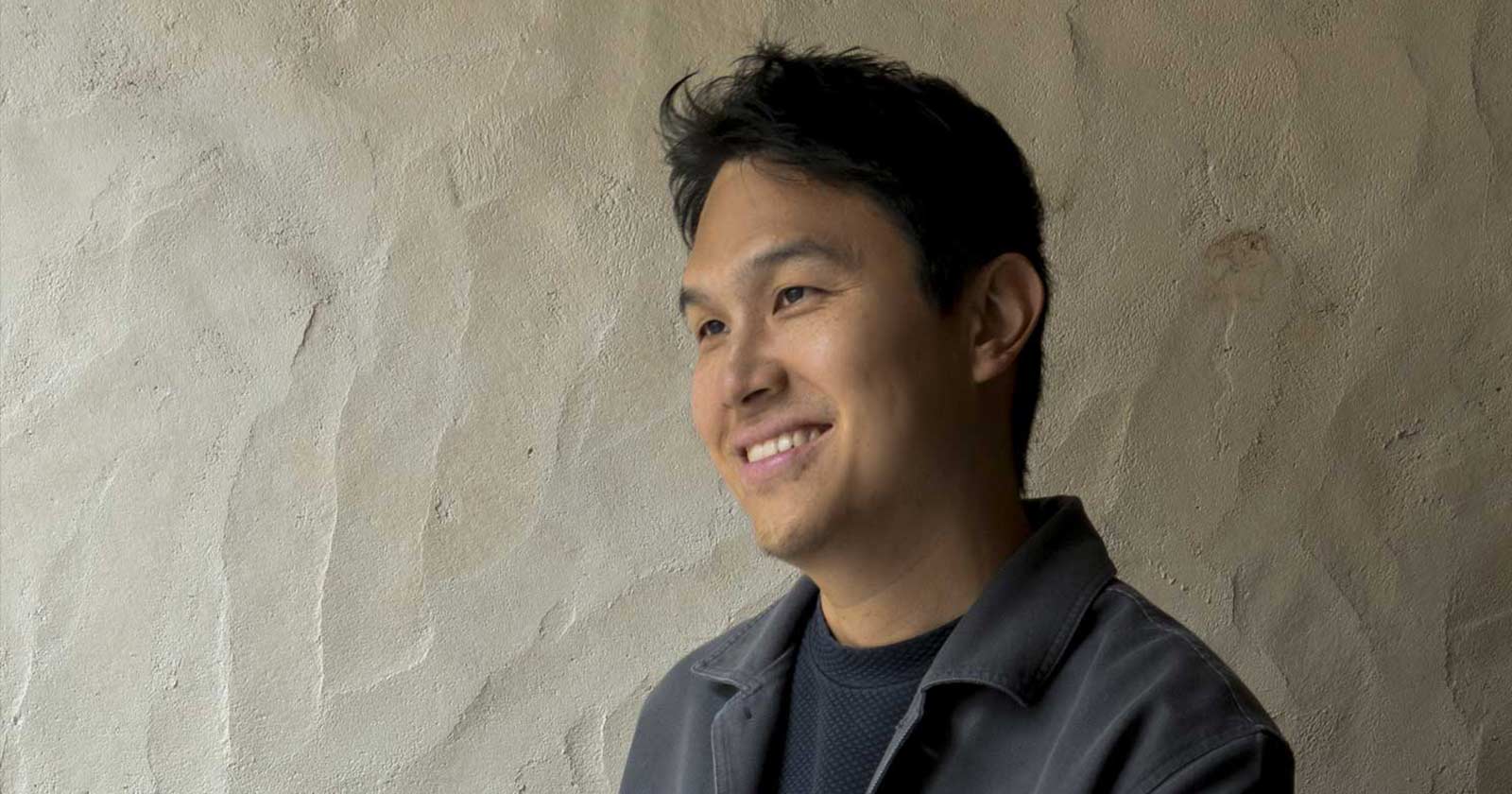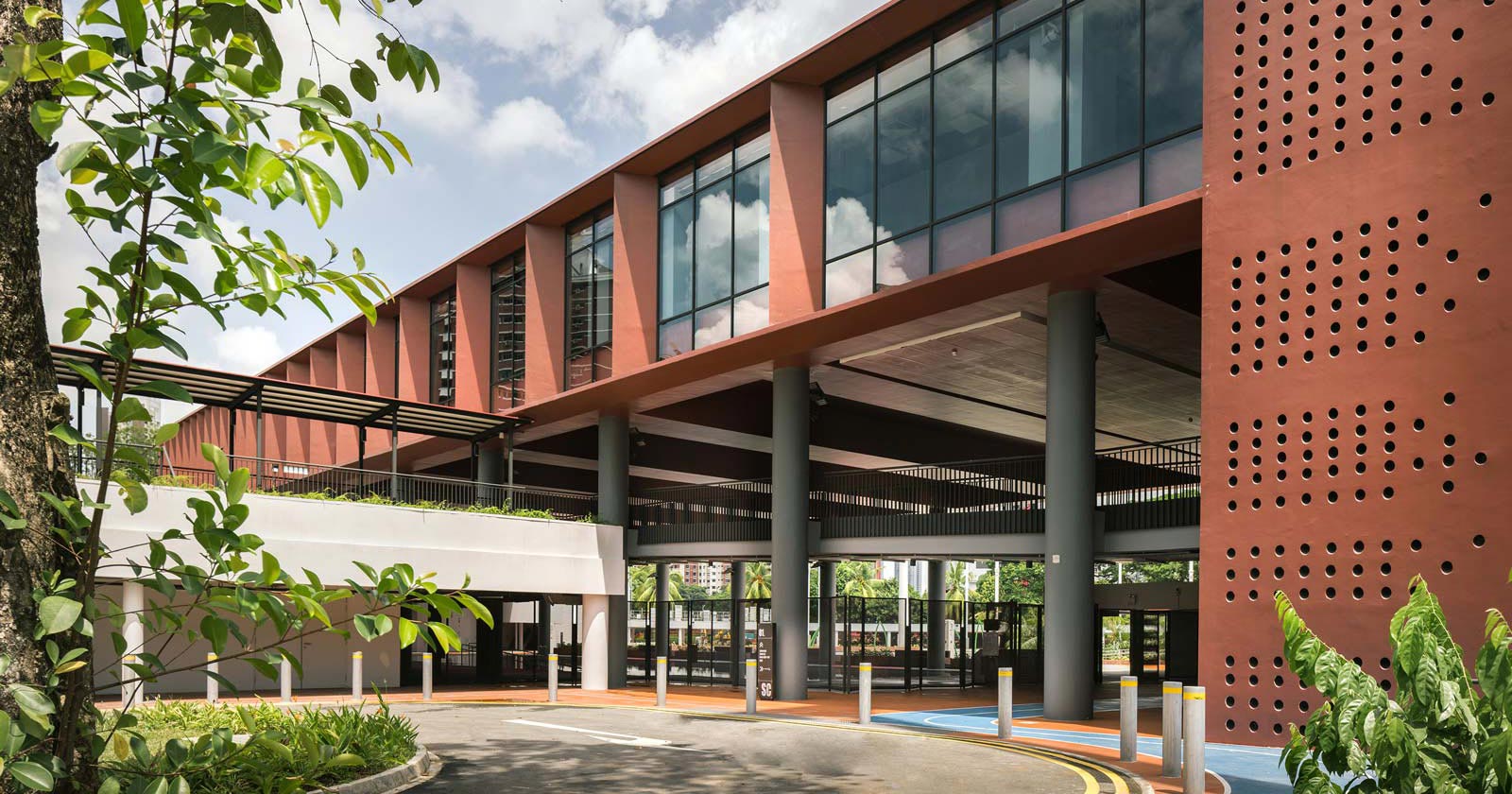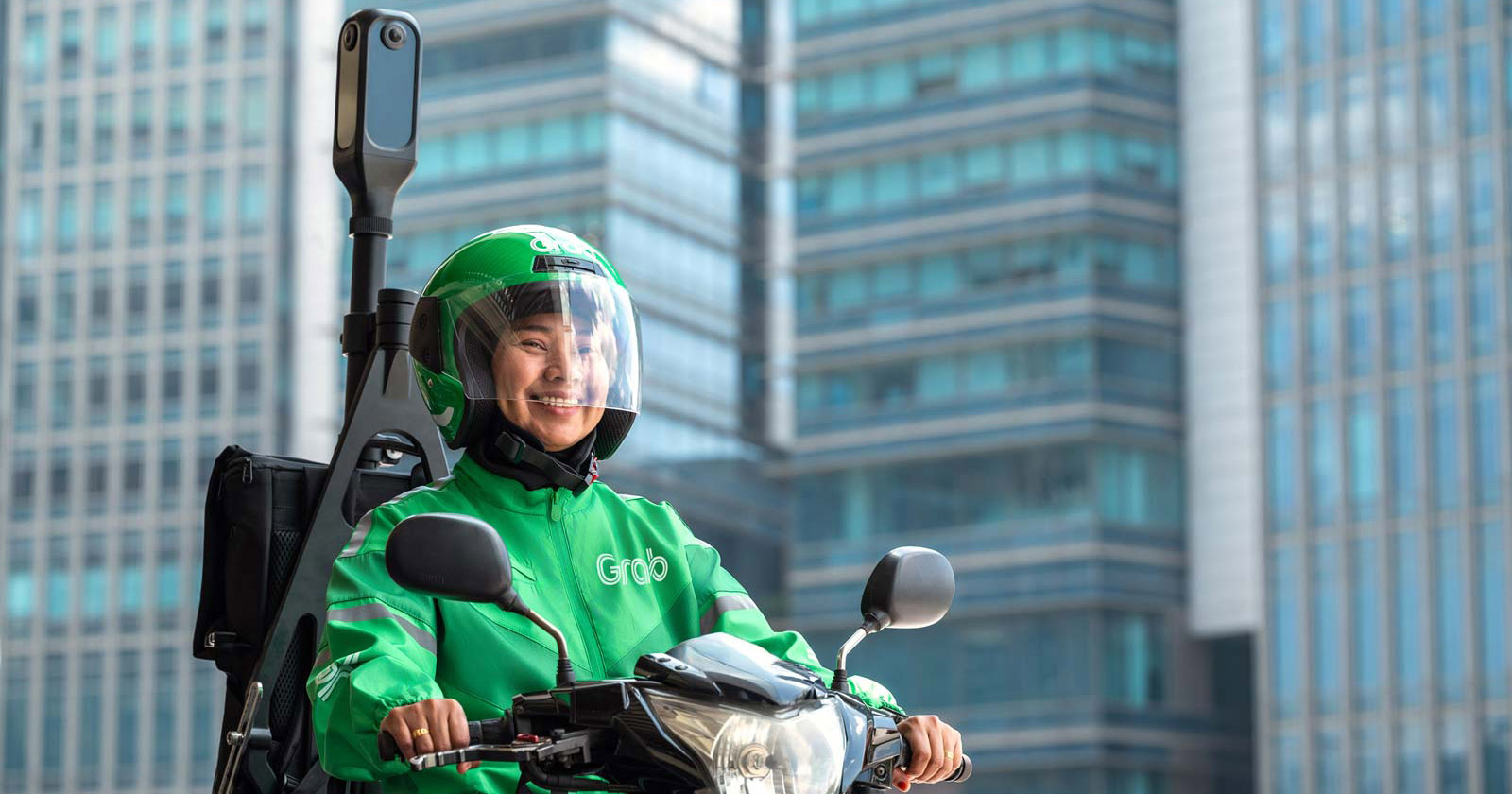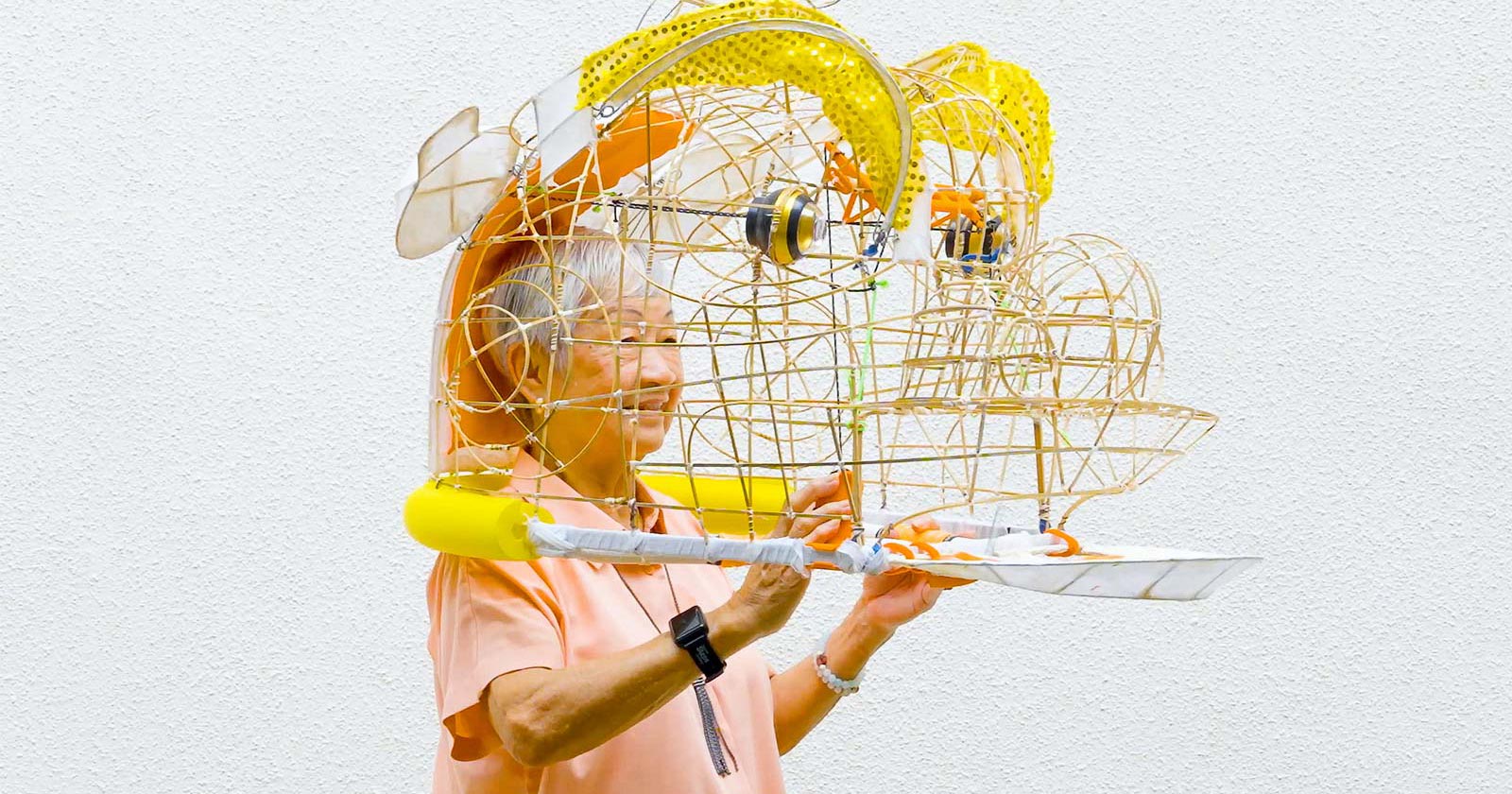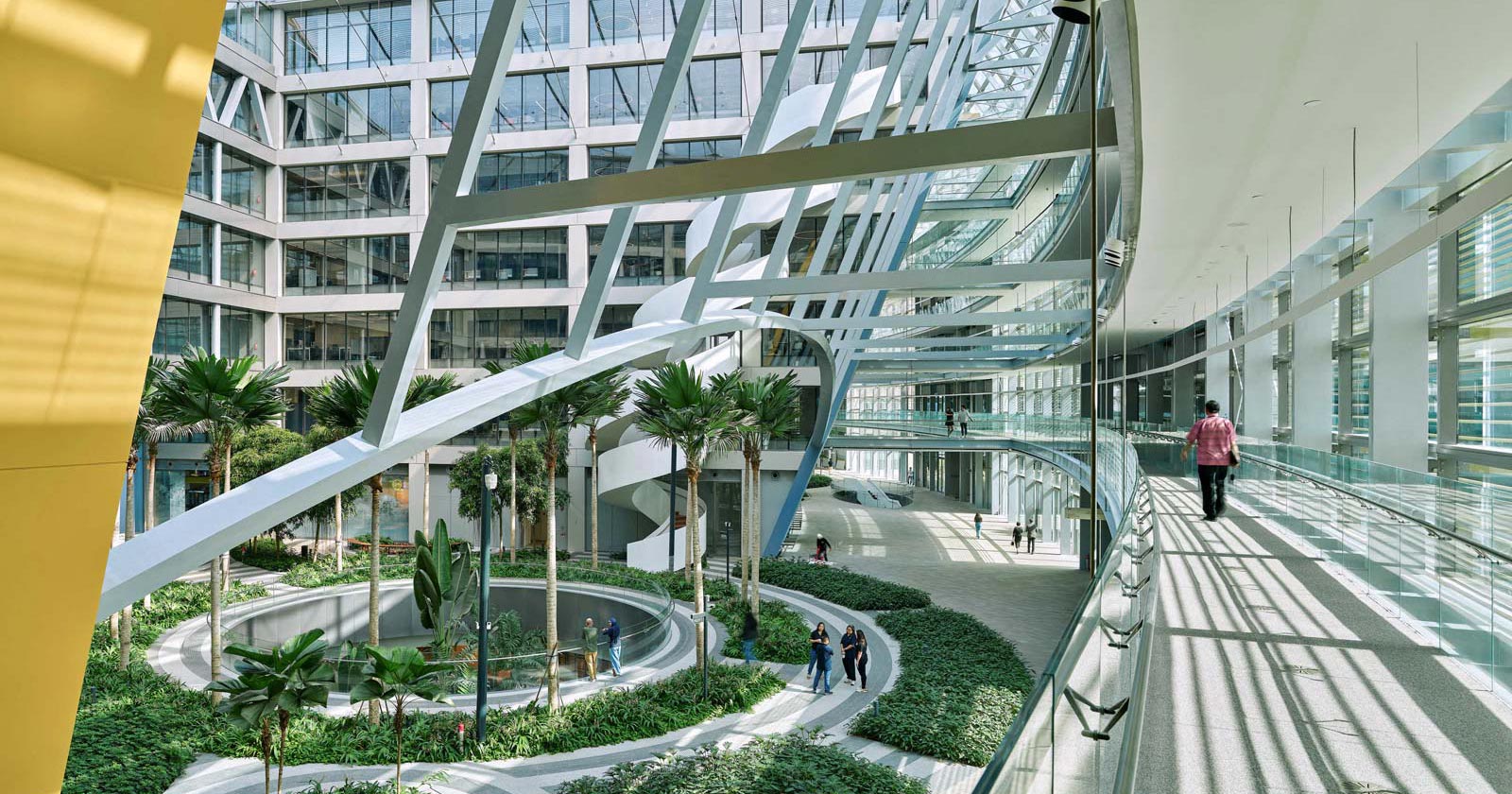DESIGN OF THE YEAR 2025
Bird Paradise
Mandai Wildlife Group in collaboration with RSP Architects Planners & Engineers
CONTACT
[email protected] and [email protected]
Moving thousands of birds from the former Jurong Bird Park to the new Bird Paradise at the Mandai Wildlife Reserve was an enormous under-taking. It was second only to the immense task of coalescing many layers of multidisciplinary knowledge and considerations into the design of an attraction that would reimagine the possibilities for bird parks.
The development of Bird Paradise was part of a larger rejuvenation project by Mandai Wildlife Group, which is seeing the addition of new features to Mandai Wildlife Reserve in Singapore’s north. The 17-hectare Bird Paradise was the first public feature to open and welcomed more than 600,000 local and international visitors in its first six months of operations in 2023.
Bird Paradise’s immersive and naturalistic environments clearly have significant visitor appeal. Mixed-species habitats were developed in eight large walk-through aviaries, each of which reflects a different biome from around the world. Two additional zones cater to penguins and highly threatened species. The habitats are collectively home to 3,500 birds from 400 species, of which 24 percent are threatened with extinction.
Managing the complex web of science and design that underpins Bird Paradise was the job of Mandai Wildlife Group’s in-house Attractions Development team, a multidisciplinary group with expertise encompassing areas like biology, architecture, and scenography. The team worked closely with key consultant RSP Architects Planners & Engineers (RSP), who led the architecture and master planning of the site.
The immersive character of Bird Paradise, alongside its impetuses of environmental stewardship and avian wellbeing, makes it an exemplary bird park. Gone are the traditional cages and enclosures that used to define bird parks. Instead, the naturalistic settings give visitors a glimpse of how birds typically behave and interact with their environments in the wild.
Behind the scenes, state-of-the-art facilities for birds such as the Avian Hospital, Avian Nutrition Centre, and Breeding and Research Centre enable staff to safely and efficiently carry out the important work of caring for birds and assuring their perpetuation for generations to come.
About the Designer
Mandai Wildlife Group is the steward of the Mandai Wildlife Reserve, a unique wildlife and nature destination in Singapore. With the ambition of creating a new generation of wildlife parks in Singapore, the Group established an in-house Attractions Development team. This multidisciplinary team brings together expertise in biology, master planning, architecture, and landscape design, as well as thematic and scenography design.
Rucha Khanderia is the Head of Design (Bird Paradise) within the Attraction Design team at Mandai Wildlife Group. She led both the in-house and consultant teams in the design and development of Bird Paradise. An architect and master planner by training, she has over two decades of experience delivering projects around the world. She obtained her Bachelor of Architecture from South Gujarat University and her Master of Architecture and Urban Design from Kent State University.
Headquartered in Singapore, RSP Architects Planners & Engineers is a global multidisciplinary architectural and interior design company, with almost seven decades of experience. The team of 1,000 people across 13 markets has successfully completed over 2,500 projects, creating spaces that prioritise people, community, and environment. RSP has received numerous P*DA Design of the Year accolades over the years in recognition of its work on projects including CapitaSpring, Jewel Changi Airport, The Pinnacle@Duxton, Henderson Waves, and LASALLE College of the Arts.
Ar. Suen Wee Kwok is the Executive Director and lead design architect of RSP with 20 years of experience. His portfolio of award-winning projects focuses on the education, mixed-use, and civic sectors. He believes that architecture should lift the human spirit and connect emotionally with users as they navigate through spaces. He was the key designer of LASALLE College of the Arts, which received the P*DA in 2008. Suen graduated with a Bachelor of Arts (Architecture Studies) and Master of Architecture from NUS.
DESIGNER
Mandai Wildlife Group
Marc Cremades, Rucha Khanderia, Tsai Chung Jay, Tatsuki Nakamura, Tan Seng Seng, Keryn Ng, Dr Nicole Tay, Dr Juan Cornejo
DESIGN ARCHITECT FIRM
RSP Architects Planners & Engineers (Pte) Ltd
Seah Chee Kien, Suen Wee Kwok, Gabriel Chen, Chan Ai Hup, Samantha Wong, Ashley Yong, Teong Mee Chen, Teo Nam Siang, Charlene Lee, Kurt Lloyd Babet
LANDSCAPE ARCHITECTS
Ramboll Studio Dreiseitl
Aecom Singapore Pte Ltd
CIVIL AND STRUCTURAL ENGINEER
Aecom Singapore Pte Ltd
MECHANICAL AND ELECTRICAL ENGINEER
Surbana Jurong Consultants Pte Ltd
LARGE AVIARY STRUCTURE DESIGN
Tensys Engineers Pte Ltd
CAPACITY CONSULTANT
Orca Consulting
PEDESTRIAN MODELLING
Vertix Asia-Pacific Pte Ltd
SIGNAGE AND WAYFINDING
Acacia Design Consultants Pte Ltd
SUSTAINABILITY STUDIES
Atelier 10 Pte Ltd
CLIENT
Mandai Wildlife Group
LIFE SUPPORT SYSTEM DESIGN (PENGUIN EXHIBIT)
Aquionics Design and Development Sdn Bhd
THEMING
Kingsmen International
Pico Art International
PLAYGROUND
Carve NL
INTERPRETIVE
SPACElogic Pte Ltd
AV AND ACOUSTIC
CCW Associates Pte Ltd
LIGHTING
Lighting Planners Associates
QUANTITY SURVEYOR
Arcadis Singapore Pte Ltd
FIRE SAFETY
Ignesis Consultants Pte Ltd
WINGED SANCTUARY AVIARY
Passage Projects
INTERIOR DESIGN (OFFICE AND BACK OF HOUSE)
RSP Architects Planners & Engineers (Pte) Ltd
INTERIOR DESIGN (F&B AND RETAIL AREAS)
Kingsmen International
INTERIOR DESIGN (TRANSITION BUILDINGS)
SPACElogic Pte Ltd
DESIGNER
Mandai Wildlife Group
Marc Cremades, Rucha Khanderia, Tsai Chung Jay, Tatsuki Nakamura, Tan Seng Seng, Keryn Ng, Dr Nicole Tay, Dr Juan Cornejo
DESIGN ARCHITECT FIRM
RSP Architects Planners & Engineers (Pte) Ltd
Seah Chee Kien, Suen Wee Kwok, Gabriel Chen, Chan Ai Hup, Samantha Wong, Ashley Yong, Teong Mee Chen, Teo Nam Siang, Charlene Lee, Kurt Lloyd Babet
LANDSCAPE ARCHITECTS
Ramboll Studio Dreiseitl
Aecom Singapore Pte Ltd
CIVIL AND STRUCTURAL ENGINEER
Aecom Singapore Pte Ltd
MECHANICAL AND ELECTRICAL ENGINEER
Surbana Jurong Consultants Pte Ltd
LARGE AVIARY STRUCTURE DESIGN
Tensys Engineers Pte Ltd
CAPACITY CONSULTANT
Orca Consulting
PEDESTRIAN MODELLING
Vertix Asia-Pacific Pte Ltd
SIGNAGE AND WAYFINDING
Acacia Design Consultants Pte Ltd
SUSTAINABILITY STUDIES
Atelier 10 Pte Ltd
CLIENT
Mandai Wildlife Group
LIFE SUPPORT SYSTEM DESIGN (PENGUIN EXHIBIT)
Aquionics Design and Development Sdn Bhd
THEMING
Kingsmen International
Pico Art International
PLAYGROUND
Carve NL
INTERPRETIVE
SPACElogic Pte Ltd
AV AND ACOUSTIC
CCW Associates Pte Ltd
LIGHTING
Lighting Planners Associates
QUANTITY SURVEYOR
Arcadis Singapore Pte Ltd
FIRE SAFETY
Ignesis Consultants Pte Ltd
WINGED SANCTUARY AVIARY
Passage Projects
INTERIOR DESIGN (OFFICE AND BACK OF HOUSE)
RSP Architects Planners & Engineers (Pte) Ltd
INTERIOR DESIGN (F&B AND RETAIL AREAS)
Kingsmen International
INTERIOR DESIGN (TRANSITION BUILDINGS)
SPACElogic Pte Ltd
1FLIGHT PATH
Hong Leong Foundation Crimson Wetlands is the only aviary at Bird
Paradise that is entirely beamless within, enabling unobstructed flight paths. Its landscape reflects coastal wetland habitats of Latin America.
2CLOSE TO HOME
A terraced rice field shapes the landscape at the Kuok Group Wings of Asia aviary, which pays homage to Southeast Asian agricultural landscapes. Architecture inspired by traditional buildings in Thailand and Bali has been integrated into the habitat.
3LAND AND WATER
A preconstruction illustration of the Hong Leong Foundation Crimson Wetlands provides a flavour of the colourful wetland scene to come.
4REST STOP
Thematic pavilions, transition buildings, and viewing decks throughout the park serve as rest stops with plenty of seating where visitors can relax and recharge.
5NATURALISTIC HABITATS
Bird Paradise incorporates eight walk-through aviaries, a penguin habitat, and a zone dedicated to birds of high conservation value. Each aviary reflects a different biome.
6MAKING A SCENE
The Shaw Foundation Australian Outback was imagined in this illustration as a dry forest environment with thematic elements such as a windmill and a water tank.
7FLOW OF LIFE
The waterfall within the Hong Leong Foundation Crimson Wetlands pays tribute to the iconic waterfall at the former Jurong Bird Park. It uses recycled water.
8SPLASH OF COLOUR
A flock of roseate spoonbills dots the landscape of reeds, waterlilies, sedges, and trees in crimson blooms at the Hong Leong Foundation Crimson Wetlands.
9MAKING A SPECTACLE
A sheltered 2,000-seat amphitheatre hosts avian presentations that showcase the flight and natural behaviours of birds. Hearing-enhancement facilities provide for an inclusive experience.
10DIVE AND GLIDE
The Ocean Network Express Penguin Cove features two seven-metre-deep saltwater acrylic tanks that offer an unobstructed underwater view of the penguins.
11SOUTHERN LIGHTS
Lighting in the Ocean Network Express Penguin Cove was designed to mimic the day and night conditions of the Sub-Antarctic Falkland Islands and complement the penguins’ breeding cycles. A domed sky features a projection of the Aurora Australis.
Insights from the Recipient
RUCHA KHANDERIA (RK): We’ve seen a significant shift in what visitors seek at wildlife parks. They see zoos as centres for education, conservation, and ethical animal care. At the same time, they look for authentic and meaningful experiences with which they can educate their children.
Visitors want to understand the broader context of species, their natural habitats, their roles, and the threats they face in the wild. Educational programmes and behind-the-scenes tours resonate these days because they show how some of the animals are looked after and treated. Hands-on activities where visitors can get involved are also increasingly popular.
For Bird Paradise, we had a unique opportunity to engage experts from various fields and completely reimagine what a modern bird park could be. We had the opportunity to do away with the traditional taxonomy-based displays and focus on holistic environmental education instead.
SUEN WEE KWOK (WK): As architects and urban planners, there was another impetus for us to consider. Nowadays, visitors expect a lot more spaces for public engagement, even before they enter the attraction. We needed to provide non-ticketed areas where the public can enjoy nature.
RK: At Bird Paradise, each habitat is inspired by real-world biomes, and visitors feel like they are stepping into real ecosystems where the birds live, not walking past enclosures. Every aviary or habitat was themed after a particular place. We conducted research all over the world, studying the micro-environments of various places that we would begin to recreate. When people visit Bird Paradise, they feel as though they are part of the animals’ environments. That was the broad vision of the park.
WK: We worked closely with the attraction designers because they are the experts in curating the bird habitats. But from the point of view of the visitor’s experience, the immediacy of up-close observations of the species was very important. Most zoos, as we found through our studies, have a fair amount of distance between the exhibit and the visitor. What is unique about Bird Paradise, and in fact, all of Singapore’s wildlife parks, is that you can come up quite close and observe the species at close proximity. You are immersed in their world; it’s not them in your world.
RK: Another changing expectation of visitors is inclusivity. People expect places to cater to diverse backgrounds and abilities. So our pathways, for example, are designed to meet universal design standards. There are gentle gradients and stopping areas that allow for engagement with the birds.
RK: We conducted an extensive EIA for the entire Mandai precinct. A key finding was that there were a lot of pathways for native birds as well as small fauna throughout the precinct. A key gesture of the overall Mandai master plan was therefore to connect the northern and southern parts of the CCNR with a bridge above a live road, allowing native animals to cross safely.
In the area where this wildlife bridge lands within the Bird Paradise site, we left a buffer zone that’s 45-to-50 m wide. That’s about 3 ha of land that we set aside as a nature buffer in direct response to the EIA in terms of maintaining animal connectivity.
We preserved large clusters of trees and, because we are very close to the reservoir, the drainage networks were designed to ensure no wastewater from our operations flowed into Upper Seletar Reservoir and the CCNR. We also limited our hours of construction to 8am to 6pm.
WK: The EIA was commissioned in 2014, prior to our engagement. At that time, very few EIAs were being done. This was the first to be made public in Singapore. We took a few guiding principles from it.
Firstly, we wanted to stitch all the green areas on the Bird Paradise site together because they were quite fragmented. There was a disused orchid garden and villages. We placed the more intensively built areas, such as the back-of-house zones and the penguin exhibit, on the areas that had already seen the most human impact. Overall, we aimed for a minimal building footprint.
Secondly, we wanted to integrate the attractions into the natural surroundings, meaning that the clearance of vegetation should be minimised to accomodate our development.
Thirdly, given the number of attractions in the entire Mandai master plan, we wanted to decentralise the crowd to avoid congestion and stress on the environment.
RK: While designing the habitats, we tried to snake the walkways around the existing clusters of trees so we were able to retain them. In some places, we went for suspension bridges because we wanted to bring people closer to the large trees, but avoid impact on the undergrowth. Throughout the park, the common areas that are outside the aviaries are designed to be eco-corridors for native birds and small fauna.
One of our key achievements was retaining one of the largest trees on the site – a Ficus benjamina with a 20-metre-wide canopy. The birds in the Rwanda Nyungwe Forest Heart of Africa aviary use it for nesting, refuge, and as a food source.
RK: Experience is one of the most powerful tools for education because people engage in an emotional way, not just in an intellectual way. When visitors walk through a misty rainforest or a wetland, they see birds in their natural context and hear the sounds of the environment. This creates visceral memories and emotional connections that inspire curiosity and sentiment. It can bring people into the larger story of conservation.
Learning can happen through different layers. We have made sure that each landscape environment feels authentic and allows opportunities for kids to engage in tactile play. We also curated elements for visitor discovery. For example, in the Hong Leong Foundation Crimson Wetlands we recreated the kind of clay wall where scarlet macaws typically feed in nature. They actually lack certain minerals in their diet, which they get from the clay. When visitors see lots of scarlet macaws feeding on that clay wall, it creates curiosity and inspires learning.
In a traditional zoo, the entry and exit points of the aviaries would typically be mesh double-door portals. At Bird Paradise, we created learning hubs at these transition points. They are designed as small buildings that contain showcases about various bird features – for example, the diversity of feathers and eggs, nest architecture, birdsong melodies, and courtships. They also provide respite from the hot sun.
WK: While you are immersed in these habitats and enjoying the exhibits, you do not realise that the comfort level is very, very high. As you walk through them, you feel cool, you feel comfortable, you are able to walk free of hazards, and the information provided along the way is curated to a very high degree. Nothing is left to chance. We call this “the design of the invisible hand”. Bird Paradise is successful in that regard.
RK: In addition to RSP, we had a suite of consultants alongside our in-house Attractions Development team. There was a very extensive engagement process with our consultants. During the design phase, we held a lot of workshops and design reviews. RSP, being the lead architect, was a key player.
We then went into a process of engagement with all the different operations teams, our Board of Directors, and various stakeholder agencies. The stakeholder engagement process was also very extensive because we needed to ensure that the vision for Bird Paradise integrated all of the associated real-world challenges and opportunities. There were a lot of expectations to meet.
WK: But everything began with the master planning. Mandai is very big, so choosing the correct site was the first challenge. That’s where the experts from the Attractions Development team were very important, because they knew what kinds of environments their bird species needed.
Insights from the ecologists and landscape architects were layered on to determine what could be retained or supplemented on the site.
Developing the design from the architecture and master planning point of view, we worked out the spatial demands of the human visitors, the vehicular needs, the human circulation, the back of house, fire safety, universal access, and construction feasibility, among others. The engineers worked on the structure, water and electrical supply, air conditioning, security monitoring, and even the animal CCTV surveillance. The lighting design was planned so the entire park dims at night and the animals can rest.
All these considerations were worked in and layered onto the attractions planned out by the Bird Paradise team. In terms of the type of project and the number of consultants, this was a once in a lifetime experience. Not many design consultants out there can claim that they have done a bird park. It was a very niche project.
RK: The ultimate masters were always the EIA and our environmental commitments. It was not an easy process to integrate all the various threads. Sometimes there were differing views, and the design needed to “arbitrate” in a way.
RK: The design allows for a high standard of animal care and safety. The large aviaries enable the free movement of the birds inside those environments. That’s one aspect. Species compatibility is another. But it’s fundamental to provide as natural of an environment as possible.
The Ocean Network Express Penguin Cove is one of the largest saltwater exhibits in the world. In other penguin exhibits, you typically see penguins on land, but they are actually seabirds. They spend most of their life underwater, so it was very important for us to provide a large saltwater environment. Not only is it the right environment for them, but it also shows visitors how they behave underwater. On land they waddle, but in the water they are so graceful! It’s almost like they are flying.
The lighting was designed to simulate the Subantarctic. Maintaining the correct photoperiod helps the penguins with their breeding cycle. Through talking with the operators of other high-quality penguin exhibits around the world, we discovered that there is a certain spectrum of amber light that penguins perceive as dark that would still allow us to carry out our operations.
The photoperiod has been very carefully designed; it allows for sunrise, high noon, and sunset conditions throughout the day, and even features a projection of the Aurora Australis at certain times of the year. It’s been successful. We welcomed the first few babies to the penguin colony recently. The birds are feeding and interacting well – these are all indicators of wellbeing.
WK: Animals will behave like animals. They won’t land in front of you just so you can take a picture. Everything, therefore, had to be considered carefully. The amount of care and consideration required when designing for animals is, I would say, two or three times higher than when designing for humans. People will know how to use a space or structure that you design for them. But you can’t tell a bird how to use a verandah or perch. Birds are a very exclusive client.
WK: When we led the P*DA jury through their site visit, everybody quickly began to convey the sense of wonder that you often see in tourists. I think that’s the magic of Bird Paradise. It’s as though you are having a childlike experience again. That’s the most surprising thing I have noticed about the visitors. They slow down and engage with the spaces deeply. They observe the birds’ behaviours, and they spend longer than we anticipated. It tells us that when we design in a way that invites exploration and wonder, people respond with curiosity and care.
RK: It’s very gratifying to see that the design has been well received. I think we are most proud of how it integrates animal welfare, guest experience, and ecological responsibility. Design, science, and nature have come together to tell the larger story about wildlife conservation.
WK: From the architectural point of view, I’m proud of the quiet intent behind the design and the way it influences without being seen. As you walk through the park as a visitor, you can enjoy it without knowing all the hard work that has gone on behind the scenes.
Citation
Jury Citation
Nominator Citation
Professor Leo Tan
Professor Emeritus of Science, NUS
Bird Paradise offers a world-class, immersive experience that redefines urban zoos and animal conservation. With a strong focus on bird conservation, it creates a rich and engaging journey, particularly for families with young children. The design was carefully conceived and executed, resulting in a seamless and interactive experience where visitors can connect closely with nature. Through the observation of and engagement with birds in a way that feels natural and dynamic, visitors gain a deeper understanding of avian species and their ecosystems.
The integration of wildlife, landscape, and visitor engagement presents an innovative model for conservation, pointing towards the future of animal preservation in urban settings. The experience at Bird Paradise is both entertaining and thought-provoking. By blending education, interaction, and carefully designed spaces, the project offers a forward-thinking vision for the role of zoos and wildlife experiences in modern cities.
Bird Paradise is an outstanding example of how urban environments can integrate nature appreciation with advanced design, while prioritising environmental and animal welfare.
At its core, Bird Paradise is dedicated not only to avian conservation but also to enriching the community by providing an avenue to connect with wildlife in today’s highly urban environment. Its design features expansive walk-through aviaries that offer a unique, immersive experience, allowing visitors to appreciate the beauty and diversity of birds in a natural and engaging setting.
As a key development principle, efforts were made to preserve trees of conservation and ecological value. These trees were identified to be conserved and incorporated into park designs where possible. For instance, the Rwanda Nyungwe Forest Heart of Africa aviary, which is inspired by the African tropical forests and woodlands, retains mature tree clusters. This approach also helps create a multi-layered rainforest experience whilst providing shade, for both birds and visitors, as well as food for the avian residents.
The park’s habitat designs are not just visually stunning but also crucial for the wellbeing of the birds. The larger aviaries provide ample space for flight and promote natural social interactions within larger flocks. Multispecies arrangements encourage interspecies interactions and behavioural diversity, enhancing both the birds’ welfare and the guest experience. Aviaries such as the Hong Leong Foundation Crimson Wetlands and Kuok Group Wings of Asia allow guests to marvel at flocks of birds and be immersed in their lively cacophony.
The Ocean Network Express Penguin Cove is another highlight. Spanning 3,000 sqm, three times the size of the previous exhibit at Jurong Bird Park, it features two saltwater acrylic tanks with a depth of 7 m. This design supports the birds’ natural behaviours both on land and in water, improving penguin welfare and offering guests a captivating view of their diving behaviours, a feature not previously available. This thoughtful approach extends to all aspects of the park, where each design element has been carefully considered to support the physical and psychological wellbeing of its avian inhabitants.
Another impressive aspect of the park is its embedded sustainability design. The Penguin Cove, for example, includes innovations such as energy-efficient air conditioning and solar panels, earning it the Building and Construction Authority’s Green Mark Platinum certification for Non-Residential Buildings.
The park has unique and innovative features integrated in its overall design. Elements such as transitions/hubs, which provide entry and exit points to the large aviaries, also serve two other key functions: They display educational and fun content about avian features such as feathers and nests and, by virtue of being air-conditioned spaces, provide much-needed respite from the weather for the guests. This illustrates how the design has been developed to provide new outcomes for guest experience and comfort.
Bird Paradise also plays a vital role in education and community engagement. Its development provided an opportunity for the team to redefine the concept of a bird park, ensuring it remains relevant to its mission of zoo-based conservation. Messaging about conservation is integrated throughout the park, promoting respect and advocacy through ethical wildlife experiences. Since its opening, Bird Paradise has welcomed numerous school groups, fostering connections to nature. It has also created opportunities for Mandai Wildlife Group to collaborate with educators in developing programmes that enhance students’ understanding of wildlife conservation and environmental stewardship.
Bird Paradise’s thoughtful design, commitment to sustainability, and focus on education underscore its role in wildlife conservation. By celebrating birds and bird life, and offering engaging educational experiences for visitors, Bird Paradise exemplifies excellence in design and enriches Singapore’s urban environment while promoting a deeper appreciation of the natural world.


